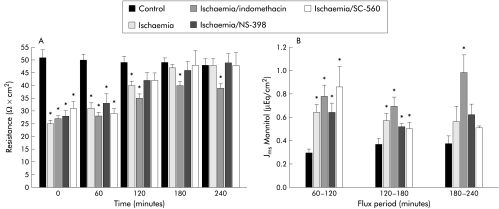Figure 1.
(A) Electrical responses of ischaemic injured porcine ileal mucosa to treatment with cyclooxygenase (COX) inhibitors. Forty five minutes of ischaemia resulted in baseline transepithelial resistance (R) ∼50% that of control. Untreated ischaemic injured tissues recovered control levels of R within 180 minutes whereas tissues treated with the non-selective COX inhibitor indomethacin (5×10−6 M) did not fully recover. However, ischaemic injured tissues treated with the selective COX-2 inhibitor NS-398 (5×10−6 M) or selective COX-1 inhibitor SC-560 (5×10−6 M) recovered levels of R not significantly different from control within three hours. *p<0.05 versus control. Significance was determined by one way ANOVA, n=12. (B) Mucosal to serosal fluxes (Jms) of mannitol across control and ischaemic injured tissues during a 240 minute recovery period. Jms mannitol in ischaemic injured tissues was significantly greater than control during the first flux period (60–120 minutes) regardless of treatment. While Jms mannitol recovered to levels not significantly different from control by 240 minutes in untreated ischaemic injured tissues or those treated with NS-398 (5×10−6 M) or SC-560 (5×10−6 M), Jms mannitol in indomethacin treated tissues remained greater than control levels throughout the recovery period. *p<0.05 versus control tissues. Significance was determined using one way ANOVA, n=8.

